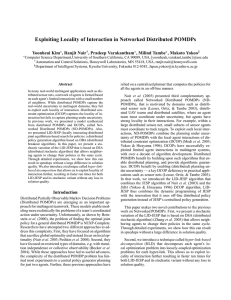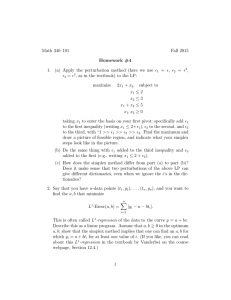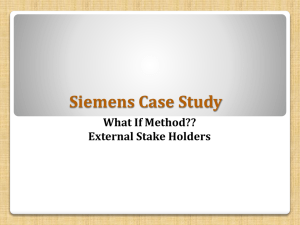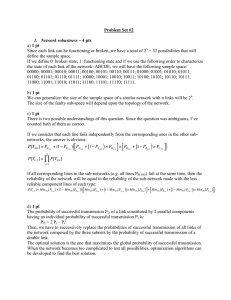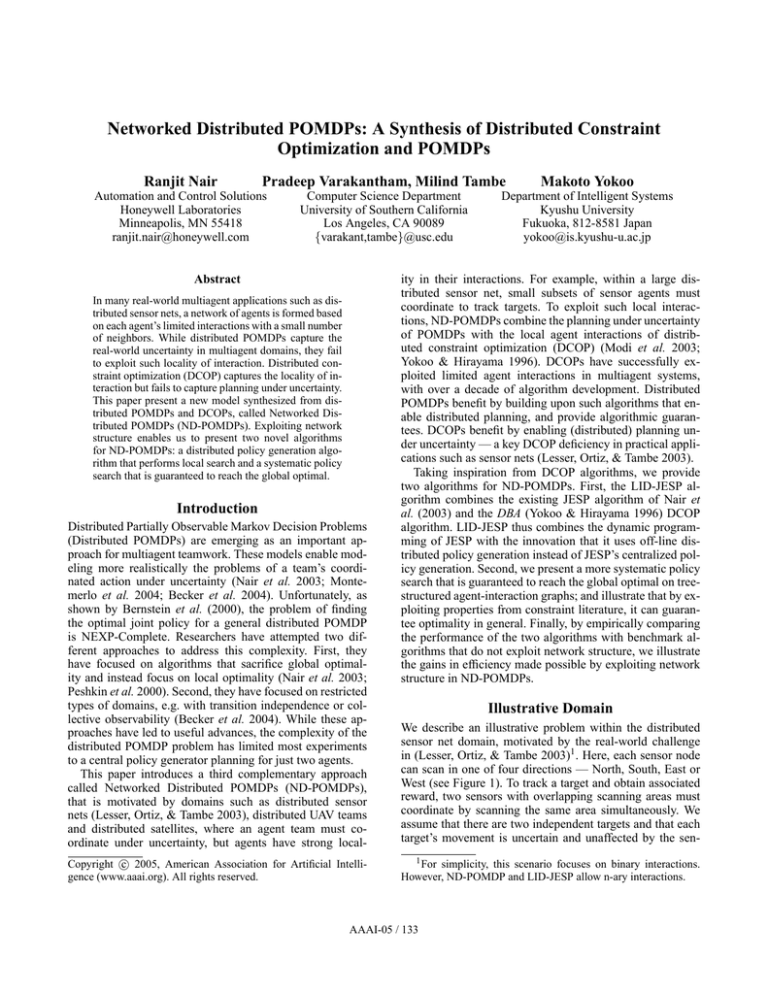
Networked Distributed POMDPs: A Synthesis of Distributed Constraint
Optimization and POMDPs
Ranjit Nair
Pradeep Varakantham, Milind Tambe
Automation and Control Solutions
Honeywell Laboratories
Minneapolis, MN 55418
ranjit.nair@honeywell.com
Computer Science Department
University of Southern California
Los Angeles, CA 90089
{varakant,tambe}@usc.edu
Abstract
In many real-world multiagent applications such as distributed sensor nets, a network of agents is formed based
on each agent’s limited interactions with a small number
of neighbors. While distributed POMDPs capture the
real-world uncertainty in multiagent domains, they fail
to exploit such locality of interaction. Distributed constraint optimization (DCOP) captures the locality of interaction but fails to capture planning under uncertainty.
This paper present a new model synthesized from distributed POMDPs and DCOPs, called Networked Distributed POMDPs (ND-POMDPs). Exploiting network
structure enables us to present two novel algorithms
for ND-POMDPs: a distributed policy generation algorithm that performs local search and a systematic policy
search that is guaranteed to reach the global optimal.
Introduction
Distributed Partially Observable Markov Decision Problems
(Distributed POMDPs) are emerging as an important approach for multiagent teamwork. These models enable modeling more realistically the problems of a team’s coordinated action under uncertainty (Nair et al. 2003; Montemerlo et al. 2004; Becker et al. 2004). Unfortunately, as
shown by Bernstein et al. (2000), the problem of finding
the optimal joint policy for a general distributed POMDP
is NEXP-Complete. Researchers have attempted two different approaches to address this complexity. First, they
have focused on algorithms that sacrifice global optimality and instead focus on local optimality (Nair et al. 2003;
Peshkin et al. 2000). Second, they have focused on restricted
types of domains, e.g. with transition independence or collective observability (Becker et al. 2004). While these approaches have led to useful advances, the complexity of the
distributed POMDP problem has limited most experiments
to a central policy generator planning for just two agents.
This paper introduces a third complementary approach
called Networked Distributed POMDPs (ND-POMDPs),
that is motivated by domains such as distributed sensor
nets (Lesser, Ortiz, & Tambe 2003), distributed UAV teams
and distributed satellites, where an agent team must coordinate under uncertainty, but agents have strong localc 2005, American Association for Artificial IntelliCopyright gence (www.aaai.org). All rights reserved.
Makoto Yokoo
Department of Intelligent Systems
Kyushu University
Fukuoka, 812-8581 Japan
yokoo@is.kyushu-u.ac.jp
ity in their interactions. For example, within a large distributed sensor net, small subsets of sensor agents must
coordinate to track targets. To exploit such local interactions, ND-POMDPs combine the planning under uncertainty
of POMDPs with the local agent interactions of distributed constraint optimization (DCOP) (Modi et al. 2003;
Yokoo & Hirayama 1996). DCOPs have successfully exploited limited agent interactions in multiagent systems,
with over a decade of algorithm development. Distributed
POMDPs benefit by building upon such algorithms that enable distributed planning, and provide algorithmic guarantees. DCOPs benefit by enabling (distributed) planning under uncertainty — a key DCOP deficiency in practical applications such as sensor nets (Lesser, Ortiz, & Tambe 2003).
Taking inspiration from DCOP algorithms, we provide
two algorithms for ND-POMDPs. First, the LID-JESP algorithm combines the existing JESP algorithm of Nair et
al. (2003) and the DBA (Yokoo & Hirayama 1996) DCOP
algorithm. LID-JESP thus combines the dynamic programming of JESP with the innovation that it uses off-line distributed policy generation instead of JESP’s centralized policy generation. Second, we present a more systematic policy
search that is guaranteed to reach the global optimal on treestructured agent-interaction graphs; and illustrate that by exploiting properties from constraint literature, it can guarantee optimality in general. Finally, by empirically comparing
the performance of the two algorithms with benchmark algorithms that do not exploit network structure, we illustrate
the gains in efficiency made possible by exploiting network
structure in ND-POMDPs.
Illustrative Domain
We describe an illustrative problem within the distributed
sensor net domain, motivated by the real-world challenge
in (Lesser, Ortiz, & Tambe 2003)1 . Here, each sensor node
can scan in one of four directions — North, South, East or
West (see Figure 1). To track a target and obtain associated
reward, two sensors with overlapping scanning areas must
coordinate by scanning the same area simultaneously. We
assume that there are two independent targets and that each
target’s movement is uncertain and unaffected by the sen1 For simplicity, this scenario focuses on binary interactions.
However, ND-POMDP and LID-JESP allow n-ary interactions.
AAAI-05 / 133
N Loc1-1
W E
1 S
2
Loc1-2
Loc2-1
3
Loc2-2
Loc1-3
5
4
Figure 1: Sensor net scenario: If present, target1 is in Loc11, Loc1-2 or Loc1-3, and target2 is in Loc2-1 or Loc2-2.
sor agents. Based on the area it is scanning, each sensor receives observations that can have false positives and false
negatives. Each agent incurs a cost for scanning whether the
target is present or not, but no cost if it turns off.
As seen in this domain, each sensor interacts with only a
limited number of neighboring sensors. For instance, sensors 1 and 3’s scanning areas do not overlap, and cannot
effect each other except indirectly via sensor 2. The sensors’ observations and transitions are independent of each
other’s actions. Existing distributed POMDP algorithms are
unlikely to work well for such a domain because they are
not geared to exploit locality of interaction. Thus, they will
have to consider all possible action choices of even noninteracting agents in trying to solve the distributed POMDP.
Distributed constraint satisfaction and distributed constraint
optimization (DCOP) have been applied to sensor nets but
they cannot capture the uncertainty in the domain.
ND-POMDPs
We define an ND-POMDP for a group Ag of n agents as a
tuple hS, A, P, Ω, O, R, bi, where S = ×1≤i≤n Si × Su is the set
of world states. Si refers to the set of local states of agent
i and Su is the set of unaffectable states. Unaffectable state
refers to that part of the world state that cannot be affected
by the agents’ actions, e.g. environmental factors like target
locations that no agent can control. A = ×1≤i≤n Ai is the set
of joint actions, where Ai is the set of action for agent i.
We assume a transition independent distributed POMDP
model, where the transition function is defined as
P(s, a, s0 ) = Pu (su , s0u ) · ∏1≤i≤n Pi (si , su , ai , s0i ), where a=
ha1 , . . . , an i is the joint action performed in state s=
hs1 , . . . , sn , su i and s0 =hs01 , . . . , s0n , s0u iis the resulting state.
Agent i’s transition function is defined as Pi (si , su , ai , s0i ) =
Pr(s0i |si , su , ai ) and the unaffectable transition function is defined as Pu (su , s0u ) = Pr(s0u |su ). Becker et al. (2004) also
relied on transition independence, and Goldman and Zilberstein (2004) introduced the possibility of uncontrollable
state features. In both works, the authors assumed that the
state is collectively observable, an assumption that does not
hold for our domains of interest.
Ω = ×1≤i≤n Ωi is the set of joint observations where Ωi
is the set of observations for agents i. We make an assumption of observational independence, i.e., we define the joint
observation function as O(s, a, ω)= ∏1≤i≤nOi (si , su , ai , ωi ),
where s = hs1 , . . . , sn , su i, a = ha1 , . . . , an i, ω = hω1 , . . . , ωn i,
and Oi (si , su , ai , ωi ) = Pr(ωi |si , su , ai ).
The reward function, R, is defined as R(s, a) =
∑l Rl (sl1 , . . . , slk , su , hal1 , . . . , alk i), where each l could refer to any sub-group of agents and k = |l|. In the sensor grid example, the reward function is expressed as the
sum of rewards between sensor agents that have overlapping areas (k = 2) and the reward functions for an individual agent’s cost for sensing (k = 1). Based on the
reward function, we construct an interaction hypergraph
where a hyper-link, l, exists between a subset of agents
for all Rl that comprise R. Interaction hypergraph is defined as G = (Ag, E), where the agents, Ag, are the vertices and E = {l|l ⊆ Ag ∧ Rl is a component of R} are the
edges. Neighborhood of i is defined as Ni = { j ∈ Ag| j 6=
i ∧ (∃l ∈ E, i ∈ l ∧ j ∈ l)}. SNi = × j∈NiS j refers to the states
of i’s neighborhood. Similarly we define ANi = × j∈Ni A j ,
ΩNi = × j∈Ni Ω j , PNi (sNi , aNi , s0Ni ) = ∏ j∈Ni Pj (s j , a j , s0j ), and
ONi (sNi , aNi , ωNi ) = ∏ j∈Ni O j (s j , a j , ω j ).
b, the distribution over the initial state, is defined as
b(s) = bu (su ) · ∏1≤i≤n bi (si ) where bu and bi refer to the distributions over initial unaffectable state and i’s initial state,
respectively. We define bNi = ∏ j∈Ni b j (s j ). We assume that
b is available to all agents (although it is possible to refine our model to make available to agent i only bu , bi and
bNi ). The goal in ND-POMDP is to compute joint policy
π = hπ1 , . . . , πn i that maximizes the team’s expected reward
over a finite horizon T starting from b. πi refers to the individual policy of agent i and is a mapping from the set of
observation histories of i to Ai . πNi and πl refer to the joint
policies of the agents in Ni and hyper-link l respectively.
ND-POMDP can be thought of as an n-ary DCOP where
the variable at each node is an individual agent’s policy. The
reward component Rl where |l| = 1 can be thought of as a
local constraint while the reward component Rl where l > 1
corresponds to a non-local constraint in the constraint graph.
In the next section, we push this analogy further by taking
inspiration from the DBA algorithm (Yokoo & Hirayama
1996), an algorithm for distributed constraint satisfaction,
to develop an algorithm for solving ND-POMDPs.
The following proposition shows that given a factored reward function and the assumptions of transitional and observational independence, the resulting value function can
be factored as well into value functions for each of the edges
in the interaction hypergraph.
Proposition 1 Given
transitional
servational
independence
and
∑l∈E Rl (sl1 , . . . , slk , su , hal1 , . . . , alk i),
Vπt (st ,~ωt ) =
and
obR(s, a) =
∑ Vπtl (stl1 , . . . , stlk , stu ,~ωtl1 , . . .~ωtlk )
(1)
l∈E
where Vπt (st ,~ω) is the expected reward from the state st
and joint observation history ~ωt for executing policy π, and
Vπt l (stl1 , . . . , stlk , stu ,~ωtl1 , . . .~ωtlk ) is the expected reward for executing πl accruing from the component Rl .
Proof: Proof is by mathematical induction. Proposition
holds for t = T − 1 (no future reward). Assume it holds for
t = τ where 1 ≤ τ < T − 1. Thus,
AAAI-05 / 134
Vπτ (sτ ,~ωτ ) = ∑Vπτl (sτl1 , . . . , sτlk , sτu ,~ωτl1 , . . .~ωτlk )
l∈E
We introduce the following abbreviations:
4
t+1 t+1
pti = Pi (sti , stu , πi (~ωti ), st+1
ωti ), ωt+1
i ) · Oi (si , su , πi (~
i )
4
ptu = Pi (stu , st+1
u )
4
rlt = Rl (stl1 , . . . , stlk , stu , πl1 (~ωtl1 ), . . . , πlk (~ωtlk ))
4
vtl = Vπt l (stl1 , . . . , stlk , stu ,~ωtl1 , . . .~ωtlk )
We show that proposition holds for t = τ − 1,
Vπτ−1 (sτ−1 ,~ωτ−1 ) = ∑rlτ−1 +
l∈E
∑
τ−1
τ−1
∑pτ−1
∑vτl
u p1 . . .pn
sτ ,ωτ
∑
l∈E
∑
τ−1 τ−1 τ
= (rlτ−1+
pτ−1
vτ−1
2
l1 . . . plk pu vl)=
l
τ
τ
τ
τ
τ
l∈E
l∈E
sl1 ,...,slk ,su ,ωl1 ,...,ωlk
neighborhood utility, and exchanges its gain with its neighbors (lines 8-11). If i’s gain is greater than any of its neighbors’ gain2 , i changes its policy (F IND P OLICY) and sends
its new policy to all its neighbors. This process of trying
to improve the local neighborhood utility is continued until termination. Termination detection is based on using a
termination counter to count the number of cycles where
gaini remains = 0. If its gain is greater than zero the termination counter is reset. Agent i then exchanges its termination counter with its neighbors and set its counter to the
minimum of its counter and its neighbors’ counters. Agent
i will terminate if its termination counter becomes equal to
the diameter of the interaction hypergraph.
Algorithm 1 LID-JESP(i, ND-POMDP)
1:
2:
3:
4:
5:
6:
7:
Compute interaction hypergraph and Ni
d ← diameter of hypergraph, terminationCtri ← 0
πi ← randomly selected policy, prevVal ← 0
Exchange πi with Ni
while terminationCtri < d do
for all si , sNi , su do
B0i (hsu , si , sNi , hii) ← bu (su ) · bi (si ) · bNi (sNi )
(2)
8:
Proposition 2 Locality of interaction: The local neighborhood utilities of agent i for joint policies π and π0 are equal
(Vπ [Ni ] = Vπ0 [Ni ]) if πi = π0i and πNi = π0Ni .
9:
10:
11:
12:
13:
14:
15:
16:
17:
18:
19:
20:
21:
prevVal
←
B0i (hsu , si , sNi , hii)
E VALUATE(i, si , su , sNi , πi , πNi , hi , hi , 0, T )
gaini ← G ET VALUE(i, B0i , πNi , 0, T ) − prevVal
if gaini > 0 then terminationCtri ← 0
+
else terminationCtri ← 1
Exchange gaini ,terminationCtri with Ni
terminationCtri ← min j∈Ni ∪{i} terminationCtr j
maxGain ← max j∈Ni ∪{i} gain j
winner ← argmax j∈Ni ∪{i} gain j
if maxGain > 0 and i = winner then
F IND P OLICY(i, b, hi , πNi , 0, T )
Communicate πi with Ni
else if maxGain > 0 then
Receive πwinner from winner and update πNi
return πi
We define local neighborhood utility of agent i as the expected reward for executing joint policy π accruing due to
the hyper-links that contain agent i:
Vπ [Ni ] =
∑
bu (su ) · bNi (sNi ) · bi (si )·
si ,sNi ,su
∑
Vπ0l (sl1 , . . . ,slk , su , hi , . . . , hi)
l∈E s.t. i∈l
Proof sketch: Equation 2 sums over l ∈ E such that i ∈ l,
and hence any change of the policy of an agent j ∈
/ i ∪ Ni
cannot affect Vπ [Ni ]. Thus, any such policy assignment, π0
that has different policies for only non-neighborhood agents,
has equal value as Vπ [Ni ].
2
Thus, increasing the local neighborhood utility of agent
i cannot reduce the local neighborhood utility of agent j if
j∈
/ Ni . Hence, while trying to find best policy for agent i
given its neighbors’ policies, we do not need to consider
non-neighbors’ policies. This is the property of locality of
interaction that is used in later sections.
Locally Optimal Policy Generation
The locally optimal policy generation algorithm called
LID-JESP (Locally interacting distributed joint equilibrium
search for policies) is based on the DBA algorithm (Yokoo
& Hirayama 1996) and JESP (Nair et al. 2003). In this algorithm (see Algorithm 1), each agent tries to improve its
policy with respect to its neighbors’ policies in a distributed
manner similar to DBA. Initially each agent i starts with a
random policy and exchanges its policies with its neighbors
(lines 3-4). It then computes its local neighborhood utility (see Equation 2) with respect to its current policy and
its neighbors’ policies. Agent i then tries to improve upon
its current policy by calling function G ET VALUE (see Algorithm 3), which returns the local neighborhood utility of
agent i’s best response to its neighbors’ policies. This algorithm is described in detail below. Agent i then computes
the gain (always ≥ 0 because at worst G ET VALUE will return the same value as prevVal) that it can make to its local
+
·
Algorithm 2 E VALUATE(i, sti , stu , stNi , πi , πNi ,~ωti ,~ωtNi ,t, T )
1: ai ← πi (~ωti ), aNi ← πNi (~ωtNi )
2: val ← ∑l∈E Rl stl1 , . . . , stlk , stu , al1 , . . . , alk
3: if t < T − 1 then
t+1 t+1
4:
for all st+1
i , sNi , su do
t+1
5:
for all ωt+1
i , ωNi do
+
val
←
Pu (stu , st+1
· Pi (sti , stu , ai , st+1
·
u )
i )
t+1
t+1 , a , ωt+1 )
,
s
·
PNi (stNi , stu , aNi , sNi ) · Oi (st+1
i i
u
i
t+1 t+1
t+1 t+1
t+1
ONi(sNi , su , aNi , ωNi ) · E VALUATE(i, si , su ,
D
E D
E
st+1
ωti , ωt+1
, ~ωtNi , ωt+1
,t + 1, T )
i
Ni
Ni , πi , πNi , ~
7: return val
6:
Finding Best Response
The algorithm, G ET VALUE, for computing the best response
is a dynamic-programming approach similar to that used in
2 The function argmax disambiguates between multiple j corj
responding to the same max value by returning the lowest j.
AAAI-05 / 135
JESP.DHere, we define
E an episode of agent i at time t as
t
t
t
t
t
ei = su , si , sNi ,~ωNi . Treating episode as the state, results
in a single agent POMDP, where the transition function and
observation function can be defined as:
t t+1
t t t t+1
t
P0 (eti , ati , et+1
i ) =Pu (su , su )·Pi (si , su , ai , si )·PNi (sNi ,
Algorithm 4 G ET VALUE ACTION(i, Bti , ai , πNi ,t, T )
1: value ← 0 D
E
2: for all eti = stu , sti , stNi ,~ωtNi s.t. Bti (eti ) > 0 do
3:
4:
+
t+1 t+1 t
t+1
stu , atNi , st+1
Ni ) · ONi (sNi , su , aNi , ωNi )
t
t+1
t+1 t+1 t
t+1
O0 (et+1
i , ai , ωi ) = Oi (si , su , ai , ωi )
A multiagent belief state for an agent i given the distribution
over the initial state, b(s) is defined as:
Bti (eti ) = Pr(stu , sti , stNi ,~ωtNi |~ωti ,~at−1
i , b)
The initial multiagent belief state for agent i, B0i , can be computed from b as follows:
5:
value ← Bti (eti ) · reward
6: if t < T − 1 then
7:
for all ωt+1
∈ Ωi do
i
t+1
8:
Bt+1
←
U
PDATE (i, Bti , ai , ωi , πNi )
i
9:
prob ← 0
10:
for all stu , sti , stNi do
D
D
EE
t+1 t+1
11:
for all et+1
= st+1
ωtNi , ωt+1
s.t.
u , si , sNi , ~
i
Ni
12:
13:
B0i (hsu , si , sNi , hii) ← bu (su ) · bi (si ) · bNi (sNi )
We can now compute the value of the best response policy via G ET VALUE using the following equation (see Algorithm 3):
Vit (Bti ) = max Viai ,t (Bti )
(3)
ai ∈Ai
+
Algorithm 5 U PDATE(i, Bti , ai , ωt+1
i , πNi )
∑
Bt+1
i
t+1
Bt+1
ωtNi )
i (ei ) ← 0, aNi ← πNi (~
t
t
t
for all su , si , sNi do
+
t+1
t+1
t t
t t+1
t t
Bt+1
i (ei ) ← Bi (ei ) · Pu (su , su ) · Pi (si , su , ai , si ) ·
t+1
t+1
PNi (stNi , stu , aNi , st+1
·
Oi (st+1
·
Ni )
i , su , ai , ωi )
t+1 t+1
t+1
ONi (sNi , su , aNi , ωNi )
5: normalize Bt+1
i
6: return Bt+1
i
Rl (sl1 , . . . , slk , su , hal1 , . . . , alk i)
l∈E s.t. i∈l
t
t+1
∑ Pr(ωt+1
i |Bi , ai ) ·Vi
+
4:
The function, Viai ,t , can be computed using G ET VALUE ACTION(see Algorithm 4) as follows:
eti
+
t+1
t t
prob ← Bti (eti ) · Pu (stu , st+1
u ) · Pi (si , su , ai , si ) ·
t+1
t+1 t+1
t+1
t
t
PNi (sNi , su , aNi , sNi ) · Oi (si , su , ai , ωi ) ·
t+1
t+1
ONi (st+1
Ni , su , aNi , ωNi )
14:
value←prob·G ET VALUE(i, Bt+1
i , πNi ,t + 1, T )
15: return value
2:
3:
if t ≥ T then return 0
if Vit (Bti ) is already recorded then return Vit (Bti )
best ← −∞
for all ai ∈ Ai do
value ← G ET VALUE ACTION(i, Bti , ai , πNi ,t, T )
a ,t
record value as Vi i (Bti )
if value > best then best ← value
record best as Vit (Bti )
return best
Viai ,t (Bti )=∑Bti (eti )
t+1
Bt+1
i (ei ) > 0 do
aNi ← πNi (~ωtNi )
D
D
EE
t+1 , st+1 , st+1 , ~
t , ωt+1
1: for all et+1
=
s
ω
do
u
Ni
i
i
Ni
Ni
Algorithm 3 G ET VALUE(i, Bti , πNi ,t, T )
1:
2:
3:
4:
5:
6:
7:
8:
9:
aNi ← πNi (~ωtNi )
reward ← ∑l∈E Rl stl1 , . . . , stlk , stu , al1 , . . . , alk
results in an increase in global utility. By locality of interaction, if an agent j ∈
/ i ∪ Ni changes its policy to improve its
local neighborhood utility, it will not affect Vπ [Ni ] but will
increase global utility. Thus with each cycle global utility is
strictly increasing until local optimum is reached.
2
(4)
ωt+1
i ∈Ω1
Bt+1
i
is the belief state updated after performing action
ai and observing ωt+1
and is computed using the function
i
U PDATE (see Algorithm 5). Agent i’s policy is determined
from its value function Viai ,t using the function F IND P OLICY
(see Algorithm 6).
Correctness Results
Proposition 3 When applying LID-JESP, the global utility
is strictly increasing until local optimum is reached.
Proof sketch By construction, only non-neighboring agents
can modify their policies in the same cycle. Agent i chooses
to change its policy if it can improve upon its local neighborhood utility Vπ [Ni ]. From Equation 2, increasing Vπ [Ni ]
Proposition 4 LID-JESP will terminate within d (=
diameter) cycles iff agent are in a local optimum.
Proof: Assume that in cycle c, agent i terminates
(terminationCtri = d) but agents are not in a local optimum.
In cycle c − d, there must be at least one agent j who can
improve, i.e., gain j > 0 (otherwise, agents are in a local optimum in cycle c − d and no agent can improve later). Let
di j refer to the shortest path distance between agents i and
j. Then, in cycle c − d + di j (≤ c), terminationCtri must
have been set to 0. However, terminationCtri increases by at
most one in each cycle. Thus, in cycle c, terminationCtri ≤
d − di j . If di j ≥ 1, in cycle c, terminationCtri < d. Also, if
di j = 0, i.e., in cycle c − d, gaini > 0, then in cycle c − d + 1,
terminationCtri = 0, thus, in cycle c, terminationCtri < d.
In either case, terminationCtri 6= d. By contradiction, if
AAAI-05 / 136
Algorithm 7 GO-J OINT P OLICY(i, π j ,terminate)
~ i t , πNi ,t, T )
Algorithm 6 F IND P OLICY(i, Bti , ω
a ,t
a∗i ← argmaxai Vi i (Bti ),
1:
πi (~
ωi t ) ← a∗i
2: if t < T − 1 then
3:
for all ωt+1
∈ Ωi do
i
4:
Bt+1
← U PDATE(i, Bti ,Da∗i , ωt+1
i
i , πENi )
~ i t , ωt+1
5:
F IND P OLICY(i, Bt+1
, πNi ,t + 1, T )
i , ω
i
6: return
LID-JESP terminates then agents must be in a local optimum.
In the reverse direction, if agents reach a local optimum,
gaini = 0 henceforth. Thus, terminationCtri is never reset
to 0 and is incremented by 1 in every cycle. Hence, after d
cycles, terminationCtri = d and agents terminate.
2
Proposition 3 shows that the agents will eventually reach
a local optimum and Proposition 4 shows that the LID-JESP
will terminate if and only if agents are in a local optimum.
Thus, LID-JESP will correctly find a locally optimum and
will terminate.
Global Optimal Algorithm (GOA)
The global optimal algorithm (GOA) exploits network structure in finding the optimal policy for a distributed POMDP.
Unlike LID-JESP, at present it requires binary interactions,
i.e. edges linking two nodes. We start with a description of
GOA applied to tree-structured interaction graphs, and then
discuss its application to graphs with cycles. In trees, value
for a policy at an agent is the sum of best response values
from its children and the joint policy reward associated with
the parent policy. Thus, given a fixed policy for a parent
node, GOA requires an agent to iterate through all its policies, finding the best policy and returning the value to the
parent — where to find the best policy, an agent requires its
children to return their best responses to each of its policies.
An agent also stores the sum of best response values from its
children, to avoid recalculation at the children. This process
is repeated at each level in the tree, until the root exhausts all
its policies. This method helps GOA take advantage of the
interaction graph and prune unnecessary joint policy evaluations (associated with nodes not connected directly in the
tree). Since the interaction graph captures all the reward interactions among agents and as this algorithm goes through
all the joint policy evaluations possible with the interaction
graph, this algorithm yields an optimal solution.
Algorithm 7 provides the pseudo code for the global optimal algorithm at each agent. This algorithm is invoked with
the procedure call GO-J OINT P OLICY(root, hi , no). Line 8 iterates through all the possible policies, where as lines 20-21
work towards calculating the best policy over this entire set
of policies using the value of the policies calculated in Lines
9-19. Line 21 stores the values of best response policies obtained from the children. Lines 22-24 starts the termination
of the algorithm after all the policies are exhausted at the
root. Lines 1-4 propagate the termination message to lower
levels in the tree, while recording the best policy, π∗i .
1:
2:
3:
4:
5:
6:
7:
8:
9:
10:
11:
if terminate = yes then
π∗i ← bestResponse{π j }
for all k ∈ childreni do
GO-J OINT P OLICY(k, π∗i ,yes)
return
Πi ← enumerate all possible policies
bestPolicyVal ← -∞, j ← parent(i)
for all πi ∈ Πi do
jointPolicyVal ← 0, childVal ← 0
if i 6= root then
for all si , s j , su do
12:
jointPolicyVal ← bi (si ) · bNi (sNi ) · bu (su ) ·
E VALUATE(i, si , su , s j , πi , π j , hi , hi , 0, T )
if bestChildValMap{πi } 6= null then
+
jointPolicyVal ← bestChildValMap{πi }
else
for all k ∈ childreni do
+
childVal ← GO-J OINT P OLICY(k, πi ,no)
bestChildValMap{πi } ← childVal
+
jointPolicyVal ← childVal
if jointPolicyVal > bestPolicyVal then
bestPolicyVal ← jointPolicyVal, π∗i ← πi
if i = root then
for all k ∈ childreni do
GO-J OINT P OLICY(k, π∗i ,yes)
if i 6= root then bestResponse{π j } = π∗i
return bestPolicyVal
13:
14:
15:
16:
17:
18:
19:
20:
21:
22:
23:
24:
25:
26:
+
By using cycle-cutset algorithms (Dechter 2003), GOA
can be applied to interaction graphs containing cycles. These
algorithms are used to identify a cycle-cutset, i.e., a subset
of agents, whose deletion makes the remaining interaction
graph acyclic. After identifying the cutset, joint policies for
the cutset agents are enumerated, and then for each of them,
we find the best policies of remaining agents using GOA.
Experimental Results
For our experiments, we use the sensor domain in Figure 1. We consider three different configurations of increasing complexity (see Appendix). The first configuration is a
chain with 3 agents (sensors 1-3). Here target1 is either absent or in Loc1-1 and target2 is either absent or in Loc2-1 (4
unaffectable states). Each agent can perform either turnOff,
scanEast or scanWest. Agents receive an observation, targetPresent or targetAbsent, based on the unaffectable state and
its last action. The second configuration is a 4 agent chain
(sensors 1-4). Here, target2 has an additional possible location, Loc2-2, giving rise to 6 unaffectable states. The number of individual actions and observations are unchanged.
The 3rd configuration is the 5 agent P-configuration (named
for the P shape of the sensor net) and is identical to Figure 1. Here, target1 can have two additional locations, Loc12 and Loc1-3, giving rise to 12 unaffectable states. We add
a new action called scanVert for each agent to scan North
and South. For each of these scenarios, we ran the LIDJESP algorithm. Our first benchmark, JESP, uses a centralized policy generator to find a locally optimal joint policy
AAAI-05 / 137
LID-JESP
LID-JESP-no-n/w
JESP
GOA
LID-JESP
1000
1000
Run time (secs)
10000
Run time (secs)
10000
100
10
1
0.1
0.01
LID-JESP-no-n/w
JESP
Config.
GOA
4-chain
100
10
1
5-P
0.1
2
3
4
5
0.01
6
2
3
5
C
3.4
4.8
7.8
4.2
5.8
10.6
G
13.6
19.2
7.8
21
29
10.6
W
1.412
1
0.436
1.19
1
0.472
6
Horizon
Horizon
(a) 3-agent chain
LID-JESP
4
Algorithm
LID-JESP
LID-JESP-no-nw
JESP
LID-JESP
LID-JESP-no-nw
JESP
LID-JESP-no-n/w
(b) 4-agent chain
GOA
LID-JESP 3
400
JESP
LID-JESP 1
LID-JESP 4
LID-JESP 2
LID-JESP 5
Table 1: Reasons for speed up. C: no. of cycles, G: no. of
G ET VALUE calls, W: no. of winners per cycle, for T=2.
10000
300
100
Value
Run time (secs)
1000
10
200
Summary and Related Work
100
1
0.1
2
3
4
Horizon
(c) 5-agent P
5
0
3-Agent
4-Agent
(d)
Figure 2: Run times (a, b, c), and value (d).
and does not consider the network structure of the interaction, while our second benchmark (LID-JESP-no-nw) is
LID-JESP with a fully connected interaction graph. For 3
and 4 agent chains, we also ran the GOA algorithm.
Figure 2 compares the performance of the various algorithms for 3 and 4 agent chains and 5 agent P-configuration.
Graphs (a), (b), (c) show the run time in seconds on a
logscale on Y-axis for increasing finite horizon T on X-axis.
Run times for LID-JESP, JESP and LID-JESP-no-nw are
averaged over 5 runs, each run with a different randomly
chosen starting policy . For a particular run, all algorithms
use the same starting policies. All three locally optimal algorithms show significant improvement over GOA in terms
of run time with LID-JESP outperforming LID-JESP-no-nw
and JESP by an order of magnitude (for high T) by exploiting locality of interaction. In graph (d), the values obtained
using GOA for 3 and 4-Agent case (T = 3) are compared to
the ones obtained using LID-JESP over 5 runs (each with a
different starting policy) for T = 3. In this bar graph, the first
bar represents value obtained using GOA, while other bars
correspond to LID-JESP. This graph emphasizes the fact that
with random restarts, LID-JESP converges to a higher local
optima — such restarts are afforded given that GOA is orders of magnitude slower compared to LID-JESP.
Table 1 helps to better explain the reasons for the speed
up of LID-JESP over JESP and LID-JESP-no-nw. LID-JESP
allows more than one (non-neighboring) agent to change its
policy within a cycle (W), LID-JESP-no-nw allows exactly
one agent to change its policy in a cycle and in JESP, there
are several cycles where no agent changes its policy. This
allows LID-JESP to converge in fewer cycles (C) than LIDJESP-no-nw. Although LID-JESP takes fewer cycles than
JESP to converge, it required more calls to G ET VALUE (G).
However, each such call is cheaper owing to the locality of
interaction. LID-JESP will out-perform JESP even more on
multi-processor machines owing to its distributedness.
In a large class of applications, such as distributed sensor nets, distributed UAVs and satellites, a large network
of agents is formed from each agent’s limited interactions
with a small number of neighboring agents. We exploit
such network structure to present a new distributed POMDP
model called ND-POMDP. Our distributed algorithms for
ND-POMDPs exploit such network structure: the LID-JESP
local search algorithm and GOA that is guaranteed to reach
global optimal. Experimental results illustrate the significant
run time gains of the two algorithms when compared with
previous algorithms that are unable to exploit such structure.
Among related work, we have earlier discussed the relationship of our work to key DCOP and distributed POMDP
algorithms, i.e., we synthesize new algorithms by exploiting their synergies. We now discuss some other recent algorithms for locally and globally optimal policy generation
for distributed POMDPs. For instance, Hansen et al. (2004)
present an exact algorithm for partially observable stochastic
games (POSGs) based on dynamic programming and iterated elimination of dominant policies. Emery-Montemerlo
et al. (2004) approximate POSGs as a series of one-step
Bayesian games using heuristics to find the future discounted value for actions. We have earlier discussed Nair
et al. (2003)’s JESP algorithm that uses dynamic programming to reach a local optimal. In addition, Becker et al.’s
work (2004) on transition-independent distributed MDPs is
related to our assumptions about transition and observability independence in ND-POMDPs. These are all centralized
policy generation algorithms that could benefit from the key
ideas in this paper — that of exploiting local interaction
structure among agents to (i) enable distributed policy generation; (ii) limit policy generation complexity by considering only interactions with “neighboring” agents. Guestrin et
al. (2002), present “coordination graphs” which have similarities to constraint graphs. The key difference in their approach is that the “coordination graph” is obtained from the
value function which is computed in a centralized manner.
The agents then use a distributed procedure for online action
selection based on the coordination graph. In our approach,
the value function is computed in a distributed manner. Dolgov and Durfee’s algorithm (2004) exploits network structure in multiagent MDPs (not POMDPs) but assume that
each agent tried to optimize its individual utility instead of
the team’s utility.
AAAI-05 / 138
Acknowledgments
This material is based upon work supported by the
DARPA/IPTO COORDINATORS program and the Air
Force Research Laboratoryunder Contract No. FA8750–05–
C–0030. The views and conclusions contained in this document are those of the authors, and should not be interpreted
as representing the official policies, either expressed or implied, of the Defense Advanced Research Projects Agency
or the U.S. Government.
5-P: This scenario consists of 5 agents arranged as in
Figure 1. Starget1 = {absent, Loc1-1, Loc1-2, Loc1-3} and
Starget2 = {absent, Loc2-1, Loc2-2}. Actions for agent i, Ai =
{turnOff, scanWest, ScanEast, ScanVert}. Tables 5 and 4
give the transition functions for target1 and target2.
absent
Loc1-1
Loc1-2
Loc1-3
Appendix
In this section, we provide the details about the 3 configurations of the sensor domain. In all three scenarios, local
/ Let Starget1 and Starget2
state of each agent is empty (Si = 0).
denote the locations of the two independent targets. The set
of unaffectable states is given by Su = Starget1 × Starget2 . The
transition functions for unaffectable states are shown below.
For each sensor, the probability of a false negative is 0.2
and the probability of a false positive is 0.1. We assume that
if two sensors scan the same target location with the target
present, then they are always successful. The reward for two
agents successfully scanning target1 is +90 and for successfully scanning target2 is +70. The reward for scanning a
location with no target is −5 for each agent that scans unsucessfully. Reward is 0 is sensor turns off.
3-chain: This scenario consists of 3 agents in a chain.
Starget1 = {absent, Loc1-1} and Starget2 = {absent, Loc2-1}.
Actions for agent i, Ai = {turnOff, scanWest, ScanEast}. The
transition functions for target1 and target2 are given in Tables 2 and 3.
absent
Loc1-1
absent
0.5
0.2
Loc1-1
0.5
0.8
Table 2: target1’s transition function (3-chain and 4-chain).
absent
Loc2-1
absent
0.6
0.25
Loc2-1
0.4
0.75
Table 3: target2’s transition function (3-chain).
4-chain: This scenario consists of 4 agents in
a chain. Starget1 = {absent, Loc1-1} and Starget2 =
{absent, Loc2-1, Loc2-2}.
Actions
for
agent
i,
Ai = {turnOff, scanWest, ScanEast}. The transition
functions for target1 and target2 are given in Tables 2
and 4.
absent
Loc2-1
Loc2-2
absent
0.4
0.2
0.3
Loc2-1
0.35
0.5
0.25
Loc2-2
0.25
0.3
0.45
absent
0.15
0.1
0.2
0.35
Loc1-1
0.5
0.5
0.1
0.05
Loc1-2
0.2
0.3
0.45
0.1
Loc 1-3
0.15
0.1
0.25
0.5
Table 5: target1’s transition function (5-P).
References
Becker, R.; Zilberstein, S.; Lesser, V.; and Goldman,
C. 2004. Solving transition independent decentralized
Markov decision processes. JAIR 22:423–455.
Bernstein, D. S.; Zilberstein, S.; and Immerman, N. 2000.
The complexity of decentralized control of MDPs. In UAI.
Dechter, R. 2003. Constraint Processing. Morgan Kaufman.
Dolgov, D., and Durfee, E. 2004. Graphical models in
local, asymmetric multi-agent markov decision processes.
In AAMAS.
Goldman, C., and Zilberstein, S. 2004. Decentralized control of cooperative systems: Categorization and complexity
analysis. JAIR 22:143–174.
Guestrin, C.; Venkataraman, S.; and Koller, D. 2002. Context specific multiagent coordination and planning with
factored MDPs. In AAAI.
Hansen, E.; Bernstein, D.; and Zilberstein, S. 2004. Dynamic Programming for Partially Observable Stochastic
Games. In AAAI.
Lesser, V.; Ortiz, C.; and Tambe, M. 2003. Distributed
sensor nets: A multiagent perspective. Kluwer.
Modi, P. J.; Shen, W.; Tambe, M.; and Yokoo, M. 2003. An
asynchronous complete method for distributed constraint
optimization. In AAMAS.
Montemerlo, R. E.; Gordon, G.; Schneider, J.; and Thrun,
S. 2004. Approximate solutions for partially observable
stochastic games with common payoffs. In AAMAS.
Nair, R.; Pynadath, D.; Yokoo, M.; Tambe, M.; and
Marsella, S. 2003. Taming decentralized POMDPs: Towards efficient policy computation for multiagent settings.
In IJCAI.
Peshkin, L.; Meuleau, N.; Kim, K.-E.; and Kaelbling, L.
2000. Learning to cooperate via policy search. In UAI.
Yokoo, M., and Hirayama, K. 1996. Distributed breakout algorithm for solving distributed constraint satisfaction
problems. In ICMAS.
Table 4: target2’s transition function (4-chain and 5-P).
AAAI-05 / 139

